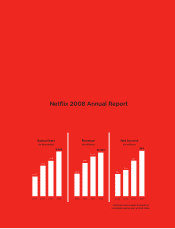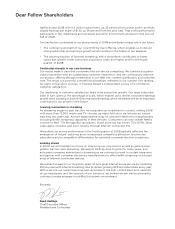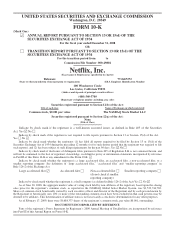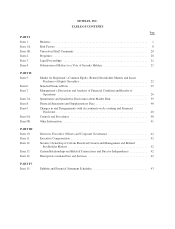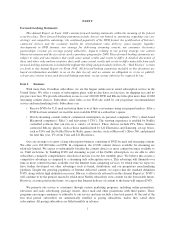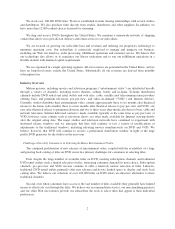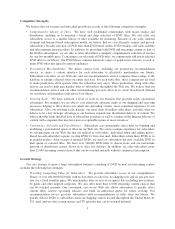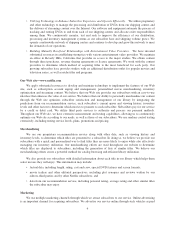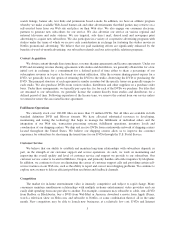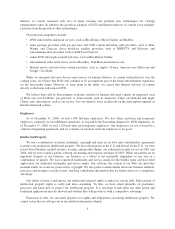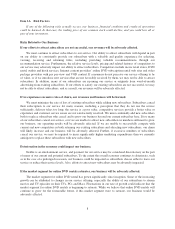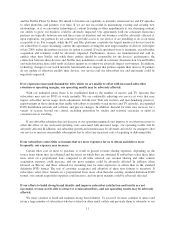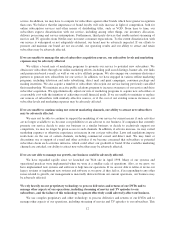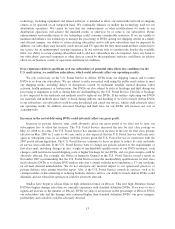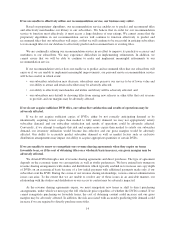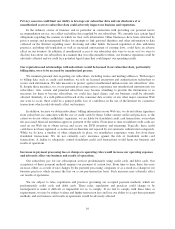NetFlix 2008 Annual Report Download - page 11
Download and view the complete annual report
Please find page 11 of the 2008 NetFlix annual report below. You can navigate through the pages in the report by either clicking on the pages listed below, or by using the keyword search tool below to find specific information within the annual report.delivery of content represent only two of many existing and potential new technologies for viewing
entertainment video. In addition, the growth in adoption of DVD and Internet delivery of content is not mutually
exclusive from the growth of other technologies.
Our principal competitors include:
• DVD rental outlets and kiosk services, such as Blockbuster, Movie Gallery and Redbox;
• video package providers with pay-per-view and VOD content including cable providers, such as Time
Warner and Comcast; direct broadcast satellite providers, such as DIRECTV and Echostar; and
telecommunication providers such as AT&T and Verizon;
• online DVD subscription rental web sites, such as Blockbuster Online;
• entertainment video retail stores, such as Best Buy, Wal-Mart and Amazon.com;
• Internet movie and television content providers, such as Apple’s iTunes, Amazon.com, Hulu.com and
Google’s YouTube.
While we anticipate that new devices and services for Internet delivery of content will proliferate over the
coming years, we believe that DVD will continue to be an important part of the home entertainment experience
for the foreseeable future. However, at some point in the future, we expect that Internet delivery of content
directly to the home will surpass DVD.
We believe there will be three primary economic models for Internet delivered content: ad supported, such
as Hulu.com and YouTube; pay-per-view or transactional, such as Amazon’s Video on Demand and Apple
iTunes; and, subscription, such as our service. It is our intent to focus exclusively on the subscription segment of
Internet delivered content.
Employees
As of December 31, 2008, we had 1,644 full-time employees. We also utilize part-time and temporary
employees, primarily in our fulfillment operations, to respond to the fluctuating demand for DVD shipments. As
of December 31, 2008, we had 1,626 part-time and temporary employees. Our employees are not covered by a
collective bargaining agreement, and we consider our relations with our employees to be good.
Intellectual Property
We use a combination of patent, trademark, copyright and trade secret laws and confidentiality agreements
to protect our proprietary intellectual property. We have filed patents in the U.S. and abroad. In the U.S., we were
issued broad business method patents covering, among other things, our subscription rental service in 2003 and
2006, and we were issued a patent covering our mailing and response envelope in 2005. While our patents are an
important element of our business, our business as a whole is not materially dependent on any one or a
combination of patents. We have registered trademarks and service marks for the Netflix name and have filed
applications for additional trademarks and service marks. Our software, the content of our Web site and other
material which we create are protected by copyright. We also protect certain details about our business methods,
processes and strategies as trade secrets, and keep confidential information that we believe gives us a competitive
advantage.
Our ability to protect and enforce our intellectual property rights is subject to certain risks. Enforcement of
intellectual property rights is costly and time consuming. To date, we have relied primarily on proprietary
processes and know-how to protect our intellectual property. It is uncertain if and when our other patent and
trademark applications may be allowed and whether they will provide us with a competitive advantage.
From time to time, we encounter disputes over rights and obligations concerning intellectual property. We
cannot assure that we will prevail in any intellectual property dispute.
6


